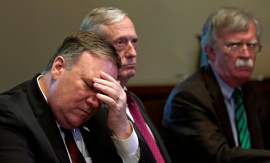
If there is any decision that comes to mind when reading the Supreme Court of the United States’ opinion in Trump v. Hawaii, it is the 1944 decision in Korematsu v. United States, an intellectual and moral nadir for the court which resulted in the legitimisation of the internment of Japanese-Americans. The court allowed Roosevelt’s government to split apart families based on sensationalised fears regarding national security. Fears that would later be proven to be based on inaccurate and misleading evidence presented by the government before the court. Donald Trump’s travel ban — in its third iteration — bears striking resemblance to the facts of Korematsu. So much so that Chief Justice Roberts was forced to confront that decision in the final paragraph of his opinion. Surely, surely, after the lessons of Korematsu, the Supreme Court would not uphold Trump’s travel ban. Sadly, it did.
I too believe, like Roberts, that the executive should enjoy a large amount of leeway in making decisions regarding national security. At first glance, there is considerable sense in what Roberts says: the executive is better suited than the Supreme Court to make decisions on national security, therefore, the court should give maximum deference to that decision-making power. But, the court has itself stated that if decision-making is motivated by strong animus towards a particular religious group then it violates the First Amendment’s guarantee of religious neutrality by the government. Roberts concedes this. The problem, according to him, was how to determine whether the president was acting on the basis of bias, or, on the basis of legitimate national security reasons? Roberts gave the president the benefit of the doubt in his opinion, focusing on the fact that the policy itself did not explicitly say that it was a ‘Muslim ban’. It is with this point that I disagree.

The test for establishing whether the First Amendment’s religious neutrality clause has been violated was laid down by the Supreme Court in Town of Greece v. Galloway (2014). The test is: whether a reasonable observer would view the government’s decision as motivated towards disfavouring a religious group? The determination of this, as aptly put by Justice Sotomayor in her dissent, is through looking, amongst other things, at the background to the decision.
The background to Trump’s travel ban displays a decision-making process steeped in bias towards Muslims. It flows from, in his own words, his belief that “Islam hates us…and we can’t allow people coming into this country who have this hatred of the United States.” In 2015, he stated he would “call for a complete and total shutdown of Muslims entering the United States.” His own campaign website read that the ban’s purpose was to ‘prevent Muslim immigration.’ Nor did Trump ever disavow these claims, in fact, in 2016 he begrudgingly stated that the reason the ban didn’t explicitly refer to Muslims was because that wouldn’t be ‘politically correct.’ Any reasonable observer upon reading such statements would concede that the policy was motivated by animus towards a religious group.
Like in Korematsu, the ban is based on blatant misrepresentation of facts before the court. According to Yale Law Professor Harold Koh, an amicus brief by former national security advisers — both Democrat and Republican — examined evidence over 15 months of the ban and concluded that the government was unable to give any conclusive evidence of legitimate national security concerns. Even more telling is The New York Times reporting that not one individual, from any of the countries mentioned in the ban, had been involved in a fatal terrorist attack in the United States in the past two decades. How then is it based on legitimate national security concerns and not animus towards Muslims?
The court’s opinion is also problematic when it is considered that just a few weeks ago it ruled that a state Civil Rights Commission by penalising a baker, for not baking a cake for a gay couple, had shown animus towards his First Amendment religious beliefs. The evidence of animus was far scarcer in that case than in this one.
Chief Justice Roberts said that this decision was nothing like Korematsu. I disagree. Like Korematsu, a vague national security threat was used to veil the real purpose behind a government policy: bigotry. Like in Korematsu, the government misstated facts to create a cloud of fear in order to get what they wanted. Like Korematsu, the Supreme Court focused on the neutrality of the text of the policy, shutting its eyes to the prejudiced reality that gave birth to it.
Published in The Express Tribune, July 3rd, 2018.
Like Opinion & Editorial on Facebook, follow @ETOpEd on Twitter to receive all updates on all our daily pieces.





















































COMMENTS (1)
Comments are moderated and generally will be posted if they are on-topic and not abusive.
For more information, please see our Comments FAQ